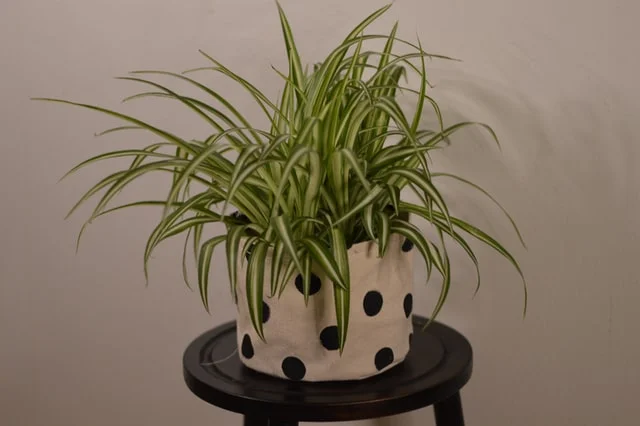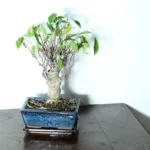Table of Contents
Introduction
This year winter has been very harsh, and you will notice that your spider plant brown tips have been due to overwatering and cold weather.
Excess water has caused root rot, and this is made worse by the cold conditions that we have suffered.
Root rot is like poor circulation for your plant, stopping the nutrition from circulating to where it is most required, and of course, this results in a lot of die-back to the ends of the leaves making spider plant brown tips inevitable. The good news is, we can turn this around.
Spider Plant Brown Tips
The spider plant is quick growing, and normally both hardy and healthy. it likes a warm climate either humidity or dry air will suit it, and it does very well as a pot plant in your home.
Another reason for the brown tips can be caused by a build-up of salt and chemicals in the soil, so best to keep your plant moist without overwatering.
Water with distilled water when this happens, don’t use chlorinated water.
What to do when Brown Tips occur in a Spider Plant
- Cut dead and brown tips off at an angle.
- use distilled water, or rainwater to keep your plant moist.
- Only water your Spider Plant every week.
- Water from the base and not the top.
Chlorine and Boron are bad for Spider Plants
Two chemicals that can damage your spider plants are chlorine and boron They are both in tap water, and our water supply can often be overchlorinated, this will result in several plants becoming brown tipped, including the spider plant.
You can actually smell the chlorine in the water, and to avoid it, water your plant with rainwater.
Boron is contained also in fertilizers and has a slightly different reaction and higher rates of boron will cause brown tips in spider plants
Getting Rid of Spider Plant Brown Tips
To do this properly you will require a few things:
- Watering can
- some bleach
- Pruning scissors
- Water-soluble /house plant fertilizer
- New bag of potting mix
1.Flush out the soil of the plant using a gallon of water, pour slowly over the soil. Continue this about three times allowing water to drain completely. If you are able to do this outside it is a good idea.
2.Water your plant with rainwater only. Let the plant dry out between watering.
3.Trim off tips of the plant with pruning scissors.
4.Fertilize your plant once every 6 months, no more often, using a water-soluble fertilizer.
5.Use pot plants with a drainage hole in the bottom for the water to drain away.
6.Put your spider plant into a larger pot of fresh potting mix, to increase its circulation of air.
7.Only water the plant from the bottom.
8.Put your plant in a hanging basket to increase the airflow around the plant.
9.If you are in an apartment establish a verticle garden on the wall of the balcony, this is a great option for spider plants.
10.Remove any slugs and snails from your plant.
Very Hot Weather and Spider Plants
Once the warm weather comes, your spider plants will not tolerate too much direct sun, the sun can also burn off the tips, so if they are not being grown indoors, allow some shade for them.
Plant them close together to keep the weeds away, and don’t water too much to avoid the brown tips.
Sometimes, during times of extreme heat, you may need to erect a shade cloth over your plants, especially if you have just nursed them back to health again.
When you are removing dead or brown leaves, never remove more than 20% of your plant at one time, as it could kill the plant.
The Spider Plant Brown Tips will Recover
With careful pruning and a small amount of water, your plant will gradually come back to life. Once it no longer has the dying leaves to support it, it will start to regenerate and grow healthy again.
A spider plant is quite hardy being a native of southern Africa, but it grows well in many other parts of the world. If you forget to water it, it won’t die, but will still be there weeks later.
If your plant is inside, they do better with more humidity in the air, your spider plant will thrive with higher humidity and you won’t need to do much more to it.
Be sure to put a hanging basket in the bathroom as this is the best place to grow your plant.
Spider Plants Brown Tips in Summer Fertilizing
Because the spider plant has very long leaves that hang down, it won’t be unusual for the tips to brown off a bit, so it is important to fertilize the plant correctly as overfertilizing can be a cause of brown tips, Always use slow-release or weak water-soluble fertilizer.
Indoors, slow-release is better and will usually stop the tips from browning off, just fertilize once a year indoors during the growing season.
This way, the plant only gets what it needs when it needs it, and it will stop brown tips from forming.
Spider Plant Chlorophytum Comosum
It may be toxic to cats, and cats appear to like it, and why would they like it. If ingested by a cat it has a mildly hallucinogenic effect on them a bit like catnip and contains chemical compounds that give a similar effect to opium.
You may want to keep the plant up high away from the cats to avoid them chewing on it. Many plants contain chemicals and toxins and there are many species that are a lot more toxic to animals than the spider plant.
Conclusion
Spider plants are a bit more complex than most of us thought, but fortunately given the right conditions, are easy enough to grow both outdoors and indoors.
When they are thriving, they make a lovely houseplant and people will admire them and often ask what they are. They are great in the office where everyone tends to neglect plants, and they help to purify the air.


